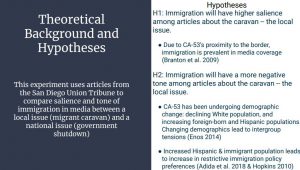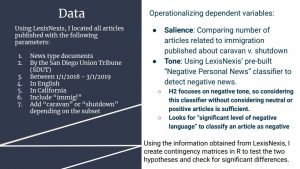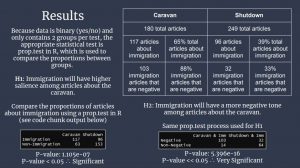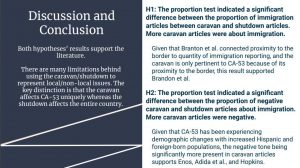
My media content analysis was approved to be slightly different than others’ analyses in the class because I had one local source and two issues I was particularly interested in: one local and one national. I compare media’s coverage and tone of the migrant caravan issue (local) with coverage of the government shutdown (national).

The caravan and shutdown have different areas of impact, and the caravan’s local influence lends it to being representative of a local issue while the shutdown represents an issue not specific to CA-53 constituents. Note that this assignment is not meant to say that the shutdown does not affect CA-53 constituents. However, it should be emphasized that the caravan attempted to cross at the San Ysidro crossing and therefore directly and specifically affects San Diegans. In this experiment, I explore the impact of the local/non-local impact on media’s sentiment when considering the portion of the conversation that relates to immigration. Given CA-53’s proximity to the border, reporting on immigration is plentiful which is supported in the literature as well as empirically by the 10,000+ articles related to immigration published by the San Diego Union Tribune (SDUT) from the start of 2018 up until March of 2019. Both hypotheses are relevant to CA-53 based on proximity to the border (H1), demographic change (H2), increasing Hispanic population (H2), and increasing immigrant population (H2). My thought process behind both hypotheses is that the media about the caravan will elicit a media presence and sentiment more directly about the community, while the media about the shutdown will elicit a more general response.
H1: CA-53 is located very closely to the Mexico/US border and increased proximity to the border indicates increased reporting (Branton et al. 2009). I anticipate immigration will be more heavily reported when the issue being reported is local.
H2: CA-53’s demographics have been shifting towards increased Hispanic and immigrant populations, therefore I expect tension. (Enos 2014 & Adida et al. 2018 & Hopkins 2010). I hypothesize the tension will be felt stronger when the issues are local: there will be a more negative sentiment around immigrants in the caravan articles than in the shutdown articles.

My media-content analysis is similar to that of my classmates because I look at the difference between local/national but I separate locality by topic being reported and others separate locality by news source. Holding the news source (SDUT) and time frame (1/1/2018-3/1/2019) constant, I compare the subsets of articles that talk about a local immigration concern — migrant caravan – and a national issue — government shutdown. I use the keywords “caravan” to create the caravan subset and “shutdown” to create the shutdown subset. I use “immig!” within both subsets to identify the amount of articles that pertain to immigration. Within these narrowed subsets that include ‘immig!” I identified the ones that are negative (process described shortly below). I compare the subsets on two dependent variables: salience and tone. I operationalize salience by comparing the proportion of immigration articles published within the given parameters on each topic and look for a significant difference between the two. I operationalize tone by utilizing the LexisNexis Negative News feature to identify how many of the articles in each subset are classified as negative. The Negative News classifier was built to specifically identify news articles that displayed significant negative tone and language, and is likely more comprehensive than any handful of keywords to indicate tone I could create. One classifier method I attempted was to utilize the “Dictionary with opinionated words from the Harvard-IV dictionary as used in the General Inquirer software” which I had scraped and put into LexisNexis as “or” terms, but there were too many terms entered for the search to run. Therefore LexisNexis’ classifier is likely more effective because it runs within each search rather than as individual search terms and subsequently allows the classifier to take more terms into consideration as well as more complex linguistic patterns.

The Results slide communicates the size and relevant features of each subset described in the table. The information from this table is used to conduct the significance test. I use a proportion test to evaluate whether there are significant differences between proportion of articles including immigration content (H1) and negative tone in articles including immigration content (H2). The proportion test (prop.test in R) is the appropriate test because the data is binary: either an article falls into a category or it does not. Prop.test takes in a contingency table as a matrix comparing binary outcomes between two groups and indicates the significance of the difference between the groups. The matrices needed for prop.test can be seen in the code chunk screenshots included for each hypothesis in the slide.
In more detail, here is how I translated the media information for H1 into a contingency table (understood as a matrix in R):
H1 <- matrix(c(117, 63, 96, 153), ncol=2)
colnames(H1) <- c(‘Caravan’, ‘Shutdown’)
rownames(H1) <- c(‘Immigration’, ‘Non-Immigration’)
The proportion test can be carried out with the following code:
H1.results <- prop.test(H1)
H1.results
The p-values of both proportion tests were <0.05 indicating evidence in favor of rejecting the null hypotheses, which is that there was no difference between salience (H1) and tone (H2) of the groups.

My experiment indicates support for the existing literature, specifically Branton et al., Enos, Adida et al., and Hopkins by supporting that local topics in media seem to produce reporting that reflects the local population’s immigration sentiments. Limitations, as mentioned in the slide, mostly have to do with the caravan:local :: shutdown:national connection. Especially when looking at salience, the caravan issue was almost exclusively an immigration issue while the government shutdown was an immigration issue as well as an abuse-of-power issue, representation issue, etc. So it could be argued that to measure salience by (immigration & caravan)/caravan is flawed because more articles will overlap between immigration and caravan than immigration and shutdown just by sheer content difference. However, I think if that were true then more than 65% of caravan articles would mention immigration, so more than immigration implications of the caravan were discussed. Nevertheless, the caravan could be replaced with any other slightly immigration-related local topic and the hypotheses’ conclusions should ideally still hold. By immigration-related I mean that using something like “charter school opening” or “local gas leak” would not be logically appropriate because they are too far removed from the immigration conversation for the lack of immigration salience to be meaningful. For future work I recommend comparing the tone regarding the migrant caravan between English and Spanish publications in San Diego. I could not find a Spanish publication with an online article archive to support this direction. I anticipate the difference between English and Spanish publications on such an immigration-salient issue to be very different in tone for a variety of reasons (authorship, audience, etc).
Despite possible limitations, the experiment indicated that local issues likely have higher proportions of immigration coverage and this immigration coverage likely has more negativity than non-local immigration coverage.